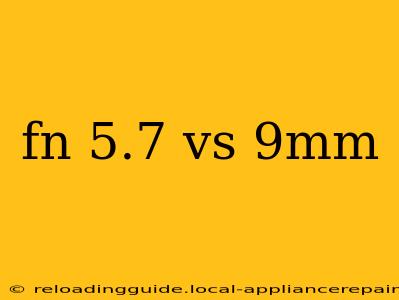Choosing between the FN 5.7x28 and the ubiquitous 9mm cartridge is a decision with significant implications, depending on your priorities. Both are popular pistol calibers, but their design philosophies and resulting performance characteristics differ considerably. This in-depth comparison will explore the strengths and weaknesses of each, helping you understand which round best suits your needs.
Ballistics: A Tale of Two Cartridges
The core difference lies in their ballistics. The 5.7x28, developed by FN Herstal, is a smaller, higher-velocity round designed for penetration and accuracy at longer ranges. Its smaller diameter and lighter bullets mean less recoil, leading to quicker follow-up shots. The 9mm Parabellum, on the other hand, is a larger, heavier-hitting round emphasizing stopping power at closer ranges. Let's break down the key differences:
Velocity and Energy:
- 5.7x28: Significantly higher muzzle velocity translates to flatter trajectory and better range. However, this comes at the cost of slightly lower energy.
- 9mm: Lower velocity results in a more pronounced bullet drop at distance, but delivers considerably more kinetic energy upon impact at closer ranges.
Penetration and Stopping Power:
- 5.7x28: Designed for penetration, especially through soft body armor. Its stopping power, while sufficient, is a subject of ongoing debate among experts and depends heavily on bullet design and placement.
- 9mm: Generally offers superior stopping power at close range due to its higher energy transfer. Penetration varies significantly based on bullet construction (e.g., jacketed hollow point vs. full metal jacket).
Recoil and Shootability:
- 5.7x28: The lighter recoil makes it easier to handle for smaller-framed shooters or those new to firearms, allowing for faster follow-up shots.
- 9mm: More substantial recoil, requiring more practice to master controlled shooting, especially in rapid-fire situations.
Applications: Where Each Cartridge Excels
The ideal cartridge depends heavily on the intended application:
FN 5.7x28 Ideal Uses:
- Personal Defense (with caveats): While effective, the 5.7's stopping power is debated, making it less ideal than the 9mm for close-quarters self-defense in some opinions. Its penetration capabilities against soft body armor are advantageous for law enforcement and military applications.
- Law Enforcement and Military: Its ability to penetrate body armor makes it a favored round in specialized tactical situations, albeit its use has limitations in many jurisdictions.
- Sport Shooting: The lower recoil and high accuracy make it a popular choice for competitive shooting.
9mm Ideal Uses:
- Personal Defense: The 9mm's superior stopping power and widespread availability make it the dominant choice for self-defense.
- Law Enforcement: The most common caliber used by law enforcement globally, due to its balance of stopping power, penetration, and availability of ammunition.
- Sport Shooting: A widely used round in various shooting disciplines, including IPSC and USPSA.
Ammunition Availability and Cost:
The 9mm enjoys significantly wider availability and generally lower cost compared to the 5.7x28. This is a crucial factor for many shooters, as consistent access to ammunition is essential for practice and readiness.
Conclusion: The Right Choice Depends on Your Needs
The "better" cartridge—the FN 5.7x28 or the 9mm—doesn't exist in a vacuum. The optimal choice hinges entirely on your intended use case. For most civilian self-defense applications, the 9mm's stopping power and readily available ammunition make it the more practical option. However, for specialized applications requiring penetration of body armor or a lower recoil profile, the 5.7x28 might be a more suitable choice. Thorough research and consideration of your specific requirements are critical before making a decision.

